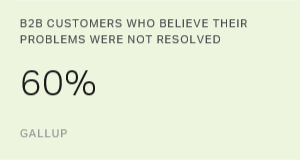Story Highlights
- Key to improving engagement is to think beyond problem resolution
- B2Bs gain a competitive advantage by handling problems when they happen
- Essential approach to resolving problems: treat customers as partners
When it comes to solving customers' problems, business-to-business (B2B) companies have a serious problem on their hands.
Recent Gallup data show that one in five B2B customers have experienced a problem with a company or product, with only 40% of them believing the B2B company resolved it. And only 5% of those customers say they are "very satisfied" with the way the company handled their problem.

With 20% of customers reporting problems, B2B companies are playing more defense than offense. Instead of putting time and energy into growing their businesses, they're constantly trying to fix problems with quality and service.
By focusing on problems, B2B companies are damaging themselves and their customer relationships, often leaving money on the table as a result. In one scenario, a professional services firm that Gallup worked with had technical issues that prevented it from providing a major report to a client. The firm did not proactively communicate with the customer that the report was going to be late; consequently, the client uninvited the firm from a meeting to pitch new business.
Giving Customers What They Want
Though B2B companies should take every possible step to stop problems from occurring in the first place, the truth is that problems will happen because they are a byproduct of doing business. But all is not lost. The key to fixing mistakes and improving customer engagement is to think beyond problem resolution -- because there is a difference between fixing a problem and engaging a customer.
Though all customers want a satisfactory resolution to their problem, they are more concerned with how the company handles that problem than with the ultimate answer to it. Companies do not absolve themselves by fixing the issue; they do so by taking care of their customers' emotional needs.
Handling Problems the Right Way
B2B companies can gain a competitive advantage if they can reduce problem incidence and get better at handling and resolving problems when they happen. When companies come out ahead on these factors, the potential business impact is quite high, given the low rates of engagement among B2B customers and the substantial relationship between engagement and business performance.
Among the B2B companies Gallup has studied, most are having fewer customer problems than in past years because they are actively measuring and managing customer engagement. Among world-class organizations -- those at the 90th percentile for controlling and reducing their problem incidence rate -- only 6% of customers encountered problems. This finding suggests that companies can minimize these problems with the right interventions.
Problem Resolution Strategies
Because of the unique nature of the B2B customer relationship, Gallup recommends that companies apply strategies that work particularly well for their customers' needs. These strategies consist of:
Focusing on what matters most. B2B customers want the companies they do business with to be experts on their industry and their customers. When problems occur, companies can use this insight and knowledge to determine how best to handle and resolve problems and to look for solutions to prevent them from occurring in the future. They can achieve this by:
- having a clear understanding of a customer's business and how problems affect that company and its customers
- developing service-recovery solutions uniquely tailored to the customer's organizational culture
- knowing the customer's industry and its day-to-day work environment
- bringing a customer creative ideas to help it achieve its business goals and create positive outcomes for that company and its customers
Treating customers as partners. Because of the complexity of B2B customer relationships, problems may not always be the result of errors or a product or service failure. Instead, problems may stem from a lack of communication, misunderstandings or conflicting messages between the B2B company and the members of the company's buying center, or among buying center members themselves. Because of this, B2B companies should build strong relationships to facilitate timely and accurate communication. When product, service or communication failures occur, B2B companies can draw on these partnerships when discussing and negotiating how to solve these problems.
Maintaining a focus on customers across all company functions. Few customer problems can be resolved by a single contact person or the account team. The problem usually requires close collaboration across customer support, product development, technology and other roles. When a problem occurs, the account team needs to quickly present the full picture to key executives and employees. In many companies -- B2B firms included -- these functional teams operate in silos; they may have competing priorities and differing understandings of the problem and how best to handle and resolve it. Effective and efficient problem resolution requires strong leadership from the account team and reward mechanisms that recognize employees for the outstanding ways they handle problems -- no matter what role they play in that process.
Including senior leaders in service recovery. Senior leaders can play a crucial role in organizing resources to design and implement a companywide service-recovery strategy and process. But one task may be the most important of all: Never underestimate the positive influence of a senior leader's sincere apology. Senior leaders also need to "walk the walk" if they want to inspire all employees to maintain a focus on customers and go above and beyond to solve problems. Finally, senior leaders' sponsorship and empowerment of the account team are vital to ensuring customer engagement during service recovery -- no matter how capable the account team is.
Defining a people strategy. To successfully implement a service-recovery strategy, B2B companies must ensure they have the right people in place. Though the company-customer partnership is a relationship between two companies, the B2B company's employees are fundamentally responsible for building that partnership, and they ultimately solve or handle customer problems. Companies should select employees who take ownership of customers' problems, who have high empathy and care about customers' feelings, and who put customers' interests before their own.
Employee engagement also matters. Gallup research shows that engaged employees are more active in learning and continually updating their knowledge of and experience with problem resolution. These employees are more likely to work to break down silos among teams and to go the extra mile in handling problems in ways that exceed B2B customers' expectations.

